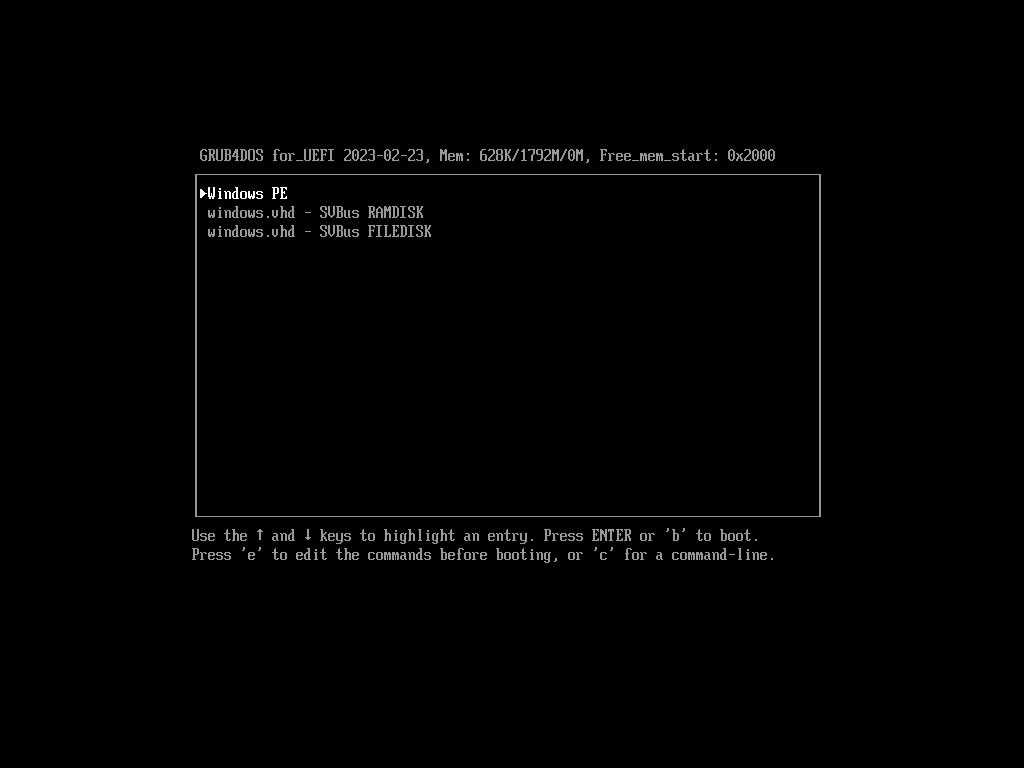
Follow the instructions in Stage 1 before proceeding. You should have a GRUB4DOS/GRUB4EFI bootable USB with menu options for WinPE and windows.vhd, with partition 2 on the USB drive containing the file \VHD\windows.vhd. This stage covers the following steps -
Boot the USB and select the menu option Windows PE -
After WinPE has finished loading, select the keyboard layout and then press the Shift+F10 keys to open a command prompt. The screenshot below shows DiskPart output after running the command list volume -
After booting WinPE, run DiskPart commands to identify the internal disk (e.g. list disk > select disk # > detail disk (refer here for more information about using DiskPart)).
After identifying the correct disk, the following series of commands were executed on a UEFI system to prepare the blank disk (with disk # edited to reflect the disk number identified in the preceding step). WARNING - this series of commands will wipe the selected disk and could result in data loss if the wrong disk is selected.
After booting WinPE, run DiskPart commands to identify the internal disk (e.g. list disk > select disk # > detail disk (refer here for more information about using DiskPart)).
After identifying the correct disk, the following series of commands were executed on a BIOS system to prepare the blank disk (with disk # edited to reflect the disk number identified in the preceding step). WARNING - this series of commands will wipe the selected disk and could result in data loss if the wrong disk is selected.
Note that the commands on BIOS firmware will differ to the commands in the UEFI section as GPT type disks are not supported (by BIOS).
This step is completed in WinPE. In this step we will be copying the VHD file created in Stage 1 from the USB disk to the internal disk prepared in the preceding step.
Use the DiskPart list volume command to identify mount points (drive letters) for the different devices and partitions -
Analyising the output from the list volume command, partition 2 of the USB drive (which should contain \VHD\windows.vhd) is identified as drive\volume D:\. The partition on the internal disk that we will be copying D:\VHD\windows.vhd to is identifed as drive\volume G:\
Use the copy command to copy D:\VHD\windows.vhd to G:\windows.vhd (the /Z parameter will display progress)
Output -
This step is optional. For convenience you may prefer not to use the USB device to boot the system now that the disk has been prepared. If you prefer to boot GRUB4DOS\GRUB4EFI from the internal disk then follow the instructions below.
Use the DiskPart list volume command to identify mount points (drive letters) for the different devices and partitions -
Analyising the output from the list volume command, partition 1 of the USB drive (which should contain GRUB4DOS\GRUB4EFI boot files) is identified as drive\volume C:\. The boot partition on the internal disk is identifed as drive\volume F:\ (on the UEFI system this is the FAT32 EFI System Partition and on the BIOS system this is the active FAT32 partition - volume label is INTERNAL-1 on BIOS and UEFI)
Use the XCOPY command to copy the contents of C:\ to F:\ (this will also copy WinPE to the internal disk) -
Alternative - just copying GRUB4DOS\GRUB4EFI files -
Reboot the system and either boot from the USB disk or the internal disk if Step 4 was completed and GRUB4DOS\GRUB4EFI copied to it.
Boot/load GRUB4DOS and select the windows.vhd - SVBus FILEDISK menu entry. There will be at least one reboot during the installation process - select the windows.vhd - SVBus FILEDISK menu option following any reboots, until the installation process has completed -
The installation process is completed once the desktop is accessible.
The SVBus developer recommends disabling hibernation - this step should be taken when the installation is completed, prior to rebooting or shutting down the Operating System. Open a command prompt (run as administrator) and execute the following command -
Following the installation, Windows can be booted by first booting GRUB4DOS\GRUB4EFI and then selecting either the windows.vhd - SVBus FILEDISK or windows.vhd - SVBus RAMDISK menu entries -
DiskPart running on the booted operating system. Note the selected disk description - SVBus Virtual Hard Disk SCSI Disk Device
DiskPart running on the rebooted operating system after selecting the windows.vhd - SVBus RAMDISK menu option. Note the selected disk description - SVBus Virtual Hard Disk SCSI RAM Device
Document date - 12th April 2023